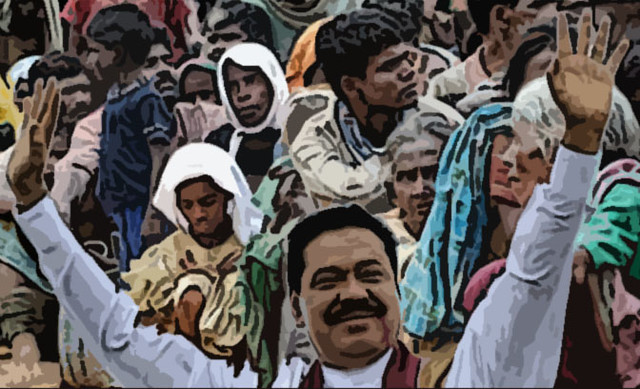Has Sri Lanka’s vision for development following years of civil war adequately addressed the country’s burgeoning levels of inequality? Using qualitative research, Kanchana N Ruwanpura, Peter Rowe, Loritta Chan, Benjamin Brown (all of University of Edinburgh, Scotland) and V Kajotha (Jaffna, Sri Lanka), highlight the poverty of vision around infrastructure-led post-war development in the country and its tragic and violent underside.
 Building construction in Colombo, Sri Lanka. Credit: Sarah Nichols, Flickr, Creative Commons.
Building construction in Colombo, Sri Lanka. Credit: Sarah Nichols, Flickr, Creative Commons.
“Yudhaya (the war) has ended for nearly a decade now. All of the millions that
were poured into the war should have been redirected towards sanvardanaya (development)
– we, the common person, should have benefitted. Do we know where these millions
have gone? These are resources that should have gone towards education, healthcare,
us, the common person; it has not come to us. We haven’t benefitted at all. The present
government is the same as the previous government – they are all corrupt; we don’t ask
this basic question about levelling the field and eradicating inequality. This is absent and
so, is there any surprise that there is seething anger amongst the people?”
Fernando, the taxi driver, shared his views as he was taking the lead author back to the airport during late night curfew hours in Sri Lanka. In a surreal drive through the hauntingly silent streets of Colombo and then the airport expressway, we started discussing the aftermath of the Easter Sunday bombings in Sri Lanka. As we talked, he revealed that he lived in Negombo and his parish church was St. Sebastian’s, which too was a target site of the bombings, and had lost neighbours, friends and kin. It elicited an animated analysis of Sri Lanka’s continuing political volatility. In the view from the everyday and below, the post-war development vision harboured by Sri Lanka’s political elites suffers abysmally for its neglect of cost-of-living issues of most concern to people.
Our concerns around a post-war polity echo academic interventions, by Harrowell (2017) and Klem (2018) for instance, who have underlined that peace and reconciliation is a long and arduous process. Sri Lanka is no exception: the peculiar synthesis of neoliberal policies coupled together with overarching nationalist logics have resulted in exclusive, investor focused planning processes taking precedence. As Harrowell (2017) notes material infrastructure projects that excludes Sri Lanka’s vibrant and complex ethnic communities, can often be a source of disquiet and disturbance, as Sri Lanka tragically discovered in April 2019.
Undoubtedly, to be in Sri Lanka at a time of resurgent terrorist attacks was surreal for those of us who grew up with three decades of ethnic violence and war. Sharika Thiranagama most eloquently captures the lingering trauma and rekindling of old fears. For those of us in the country at the time, it was not necessarily more bombings we feared in the immediate aftermath but the possible unleashing political polarisation and communal violence directed against yet another minority, whose claim to the Sri Lankan ‘nation’ is as equally valid and legitimate as the Sinhala majority.
This violence came in various guises as many commentators have traced. For instance, many of these interventions focus on the pervasive corruption, how politicians have tolerated the rise in extremist violence against minorities by ethno-nationalist groups. In particular, Tisaranee Gunasekara outlines, ethnic or religious fault-lines have overdetermined class contradictions. Even though all these mediations hint at the economic inequities that may pronounce these fault-lines, there is little explicit analysis of how the economic post-war development trajectory may also be a contributory factor to Sri Lanka’s continuing political volatility.
Over the past three years, we have been conducting fieldwork on the ways in which the political imagination of Sri Lanka was reconstituted in the aftermath of a three-decade ethnic conflict and war. Post-war Sri Lanka was to be connected through a vast array of highways and road networks, ostensibly uniting warring communities through the common endeavour of national development and economic growth. Under a neoliberal strategy to stimulate economic activity through expanding trade and the movement of goods from manufacturing sites (Ruwanpura 2018), where connectivity, roads and transport infrastructure took a pivotal role, and was promoted as the panacea for politically and economically fractured Sri Lanka. It reflected what Venugopal (2018) has noted as a liberal economic policy response to a protracted political problem and conflict; or to paraphrase Li (2017), a situation where the political challenge of rebuilding trust and reconciliation was ‘rendered technical’. Moreover, in the past decade after the end of the war, Sri Lanka’s politicians very quickly reoriented away from focusing on the nation to making claims about the nation’s place on the geo-political map – and particularly on China’s Belt and Road Initiative. Consequently, Colombo is crammed with construction sites, with highways connecting an envisioned Port City to high-rises at various stages of construction. For whom is this reimagined Sri Lanka of high-rises, highways and port cities?
If we look at Sri Lanka’s Gini-coefficient from the mid-1980s, several years after the advent of the ‘open economy’, the country witnessed a spike in inequality from the turn of the 20th century. It seems that despite the end of the war, and indeed since its culmination, inequality has been increasing.
| Year | 1985 | 1990 | 1995 | 2002 | 2006 | 2009 | 2012 | 2016 |
| Gini Co-Efficient | 3.25 | 3.24 | 3.54 | 4.1 | 4.03 | 3.64 | 3.92 | 3.98 |
Source: World Bank Data (2019) [In reading the Gini co-efficient, a figure towards 0 suggests perfect equality while 1 denotes high inequality; higher figures away from 0 suggests growing inequality]
During our fieldwork, material hardship featured as a constant refrain. Our respondents felt that placing Sri Lanka’s citizens on an equal economic footing was not a priority. This feeling of neglect, despite politicians, like Harsha de Silva who spoke about Sri Lanka needing to prioritize equity and social justice. It is telling of a policy platform bereft of serious class analysis.
Returning to the taxi driver Fernando’s ‘view from below’ in a context of growing inequality and limited political interventions to address it, anger and disenchantment are an unsurprising by-product. It is a fault line that politicians continue to downplay, not just because neoliberal economic policies play into the geopolitical jostling between China, the USA and its allies, but also as it provides the very economic framework where political corruption can flourish. The sorry consequence is that after a haunting hiatus between April 21st and May 21st 2019 [a few days after a long weekend associated with Vesak poya (a full moon holiday celebrating the birth, attainment of nirvana and passing away of the Buddha) day in Sri Lanka], by early June, Sri Lanka’s construction boom of highways, high-rises and ports was back in business. Given the country’s brazen and growing inequality, is this new wave of ‘development’ just another hollow promise?
This article gives the views of the author, and not the position of the South Asia @ LSE blog, nor of the London School of Economics. Featured photo: Building works, Colombo. Credit: Sarah Nichols, Flickr, Creative Commons.
Acknowledgements: This research was funded by a European Research Council (grant agreement number: 616393) for the project Roads: An Ethnographic Project on Roads and Politics of Thought in South Asia.







